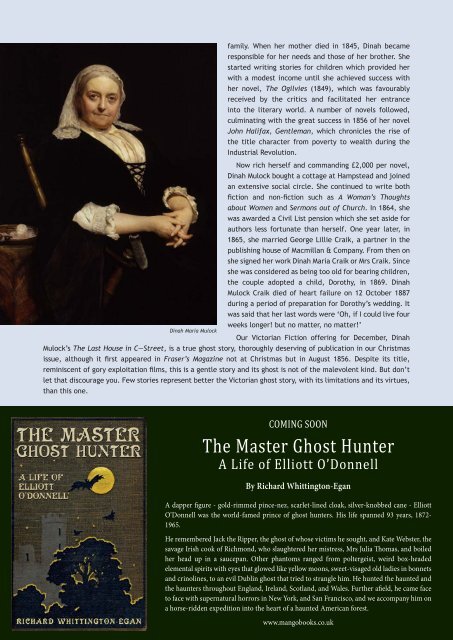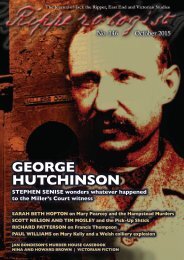Edmund Reid
nuhf574
nuhf574
You also want an ePaper? Increase the reach of your titles
YUMPU automatically turns print PDFs into web optimized ePapers that Google loves.
Dinah Maria Mulock<br />
family. When her mother died in 1845, Dinah became<br />
responsible for her needs and those of her brother. She<br />
started writing stories for children which provided her<br />
with a modest income until she achieved success with<br />
her novel, The Ogilvies (1849), which was favourably<br />
received by the critics and facilitated her entrance<br />
into the literary world. A number of novels followed,<br />
culminating with the great success in 1856 of her novel<br />
John Halifax, Gentleman, which chronicles the rise of<br />
the title character from poverty to wealth during the<br />
Industrial Revolution.<br />
Now rich herself and commanding £2,000 per novel,<br />
Dinah Mulock bought a cottage at Hampstead and joined<br />
an extensive social circle. She continued to write both<br />
fiction and non-fiction such as A Woman’s Thoughts<br />
about Women and Sermons out of Church. In 1864, she<br />
was awarded a Civil List pension which she set aside for<br />
authors less fortunate than herself. One year later, in<br />
1865, she married George Lillie Craik, a partner in the<br />
publishing house of Macmillan & Company. From then on<br />
she signed her work Dinah Maria Craik or Mrs Craik. Since<br />
she was considered as being too old for bearing children,<br />
the couple adopted a child, Dorothy, in 1869. Dinah<br />
Mulock Craik died of heart failure on 12 October 1887<br />
during a period of preparation for Dorothy’s wedding. It<br />
was said that her last words were ‘Oh, if I could live four<br />
weeks longer! but no matter, no matter!’<br />
Our Victorian Fiction offering for December, Dinah<br />
Mulock’s The Last House in C—Street, is a true ghost story, thoroughly deserving of publication in our Christmas<br />
issue, although it first appeared in Fraser’s Magazine not at Christmas but in August 1856. Despite its title,<br />
reminiscent of gory exploitation films, this is a gentle story and its ghost is not of the malevolent kind. But don’t<br />
let that discourage you. Few stories represent better the Victorian ghost story, with its limitations and its virtues,<br />
than this one.<br />
COMING SOON<br />
The Master Ghost Hunter<br />
A Life of Elliott O’Donnell<br />
By Richard Whittington-Egan<br />
A dapper figure - gold-rimmed pince-nez, scarlet-lined cloak, silver-knobbed cane - Elliott<br />
O’Donnell was the world-famed prince of ghost hunters. His life spanned 93 years, 1872-<br />
1965.<br />
He remembered Jack the Ripper, the ghost of whose victims he sought, and Kate Webster, the<br />
savage Irish cook of Richmond, who slaughtered her mistress, Mrs Julia Thomas, and boiled<br />
her head up in a saucepan. Other phantoms ranged from poltergeist, weird box-headed<br />
elemental spirits with eyes that glowed like yellow moons, sweet-visaged old ladies in bonnets<br />
and crinolines, to an evil Dublin ghost that tried to strangle him. He hunted the haunted and<br />
the haunters throughout England, Ireland, Scotland, and Wales. Further afield, he came face<br />
to face with supernatural horrors in New York, and San Francisco, and we accompany him on<br />
a horse-ridden expedition into the heart of a haunted American forest.<br />
Ripperologist 147 December 2014 48<br />
www.mangobooks.co.uk




